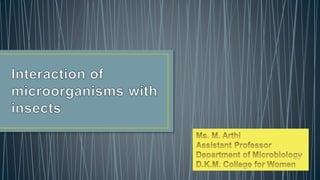
Interaction of microorganisms with Insects.pptx
- 2. Insects are the most abundant class of animals living today, there are about over one million spp. are known. 20 % of insects support the symbiotic m’orgs. This symbiotic association provides nutritional advantages or protection. These symbionts found on the insect surface or in their digestive tracts. Endosymbionts – intracellular bacteria localized to specialized organs within the insect.
- 3. • Microbial symbionts are acquired by the host from Types of heritable symbionts: • Heritable symbionts are obligate symbionts becoz they lack free-living replicative stage. • Bacteria requires host for replication. An environmental reservoir • Horizontal transmission (less specificity) Transferred directly from the parent to the next generation • Heritable or vertical transmission
- 4. Based on the host dependence Primary symbionts Eg: Buchnera aphidicola Required for host reproduction Restricted to specialized region called bacteriome. Within the bacteriome the bacterial cells reside in a specialized cells called bacteriocytes Secondary symbionts Eg: Serratia symbiotica Not required for host reproduction Not always present in every spp. Not restricted to a particular tissues Eg:pathogens invade different cell types & live extracellularly within the insects hemolymph. 2 symbionts can invade bacteriocytes and Co-reside with primary symbionts or Displace them • Take nutritional advantage and protection from the insect host • some provide protection to the host against invasion by pathogens or predators. Eg: In Drosophila neotestacea – Spiroplasma protects the host from parasitic nematode worm.
- 5. • Most heritable symbionts are transmitted maternally, • These symbionts has the potential to manipulate the host reproductive system and increasing the frequency of female progeny. The suppression of male progeny helps in the expansion of infected individuals and also increase the rate of spread through the insects • Eg: Rickettsia infection in Whitefly population: 1% infected in 2000, 97% infected in 2006. • Wolbachia infection in Drosophila simulans spread within 3 years
- 6. • Used in pest management & the control of vector borne disease. • Symbiotic Wolbachia (reproductive manipulators) – distributed among insect spp. The sperm of infected male insect sterilize the uninfected females. This mechanism is used to control elephantiasis by infecting the Culex quinquefasciatus. • Presence of symbionts decrease the transmission of disease • Eg: Wolbachia infected Aedes aegypti mosquitoes less likely to transmit the dengue virus. • Sometimes presence of symbionts increase the disease transmission • Eg: Hamiltonella bacteria (Enterbacteriaceae) infected whiteflies transmit
- 7. Nutrition significance of insect symbionts • 1. Aphid – Buchnera aphidicola (γ proteobacterium) Aphids feed on the carbohydrate rich but nutrient-poor sap of phloem vessels in plants. The symbionts provide the nutrients which is not acquired by their primary diet Insect harbours the bacteria Buchnera in their bacteriomes (cytoplasm) This bacteria provides 9 essential amino acid to the host If the insect is treated with antibiotics, the insect starves and dies Likewise Buchnera lacks the enzyme needed for the synthesis of leucine which was provided by the Aphid host
- 8. Aphids Primary Symbiont Buchnera Secondary Symbiont Provide nine essential amino acids Provide enzyme for leucine biosynthesis Posses 2 genes for Tryptophan biosynthesis Remaining genes is located in the chromosome of secondary endosymbiont
- 9. 2. Mealybugs (Planococcus citri) – Betaproteobacterium These bugs have two stable bacterial symbionts Candidatus Termblaya princeps (Betaproteobacterium) Candidatus Moranella endobia (gammaproteobacterium) These symbionts provide eesential amino acids to the host Moranella bacterium lives inside the Tremblaya (bacterium within a bacterium symbiosis) Tremblaya lost their genome for tRNA synthetases which was supplied by the
- 10. • Termites has symbiotic association with Protists and bacteria that digest lignocellulosic material. • Like the rumen of herbivorous animals, insect gut also provides a protective niche for microbial symbionts and in return, the insect gains access to the nutrients provided by the symbionts. • Microbial symbionts in termite decompose the greater part of cellulose (74-99%) & hemicellulose (66-87%) ingested by the termites
- 11. • Termite gut consists of • Foregut (crop & muscular gizzard) • Tubular midgut (site of secretion of digestive enzymes & absoption of nutrients). • Large hindgut (consists of single chamber called paunch) – harbours diverse microbial community and it is the major site of nutrient absorption. • Hindgut communities • 12 phyla of bacteria & few Archaea • Treponema – predominant • Phylum - Fibrobacteres
- 13. • The flagellated protozoa Trichonympha live in the gut of termites & wood roaches Termites (lacks cellulase) Protozoa (contains cellulase) Cellulose Acetate & other products Metabolize Oxidise Eat wood Carbon & energy source